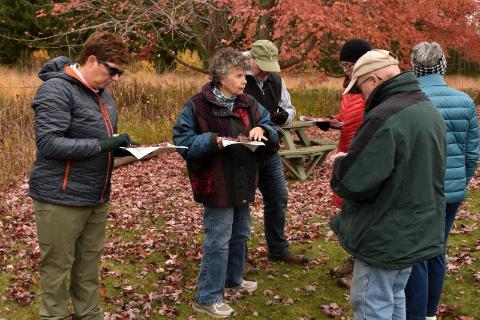At Crossroads, we are observing the plants and animals as they make their final preparations for winter, and we humans are preparing for the snowy season as well. But fall landscape work isn’t what it used to be.
A quote from Maya Angelou has become a mantra for Crossroads’ restoration efforts: “Do the best you can until you know better. Then, when you know better, do better.”
Consequently, when we learned that native trees support the moths and butterflies that produce the caterpillars which are the primary food source for songbird nestlings, we have been planting thousands of native trees and shrubs on our preserves.
This year, after learning about the needs of insect pollinators, especially the needs of our native bees, we gave the Bird and Butterfly Garden at the entrance of the Collins Learning Center a makeover, planting regionally appropriate native wildflowers.
We have been thrilled that others in the community are similarly planting native trees, shrubs and flowers to help the pollinators.
Alas, many of these well-meaning efforts are jeopardized by our collective compulsion to “clean up” our lawns and properties every autumn.
We have learned a great deal from the Xerces Society for Invertebrate Conservation which is “an international nonprofit organization that protects the natural world through the conservation of invertebrates and their habitats.” As a science-based organization, it conducts research and relies upon the most up-to-date information to guide its conservation work.
Thanks to their efforts, we now know that native plants provide the food for beneficial insects, and that nesting and overwintering habitat is probably the most crucial factor influencing the populations of native insects. They strongly advocate for “leaving the leaves.”
Just as it seems misguided to put food scraps in a landfill – which means valuable minerals and nutrients are lost forever – the accepted tradition of removing autumn leaves from our properties really doesn’t make a lot of sense. The leaves are a free source of fertilizer because they contain the very nutrients our plants need to thrive.
Moreover, according to current Xerces research, “the majority of butterflies and moths use leaf litter for winter protection of eggs, caterpillars, chrysalises, and adults,” and “roughly 70% of our native bees nest in the ground.”
Fallen leaves provide winter habitat for beneficial insects while protecting tender plants from the freeze/thaw cycles and moisture loss.
For years, we have been told that fallen leaves are hard on lawns. OK, thick soggy mats of oak leaves are not great, but a thin layer of decomposing leaves actually protects the grass and provides nutrients to a lawn.
Landscaping books, articles and posts have explained that using a leaf mulching blade on a lawn mower would chew up the leaves, quickly releasing nutrients—and that is true. But the mulching blade also chews up the creatures living in the leaves.
It seems that whole leaves offer the greatest protection to beneficial insects, and that raking, or maybe better, using a leaf blower or a leaf vacuum, is the best way to clean up a lawn if one is compelled to do so. Whole leaves can then become mulch for gardens, shrubs and, hopefully, native wildflower plantings or designated wild areas of a lawn.
Leaf litter is not litter. It may be too late this year, but now that we know better, we can do better in the future. Fallen leaves are an essential part of the food web, passing the energy from the Sun to the birds, the bees and the ecosystem as a whole.
And speaking of birds and the food web, Saturday Science – our weekly activity for elementary students and their families – will be “Fit the Bill,” a fun, interactive way to learn about the food gathering adaptations of various types of birds. Because the demonstrations include edible examples, we ask parents to email coggin@crossroadsatbigcreek.org if their children have dietary restrictions.
Crossroads at Big Creek Learning Center and Nature Preserve is located at 2041 Michigan Street, Sturgeon Bay. Crossroads is a 501(c)3 organization committed to offering education, conducting research and land restoration, and providing outdoor experiences to inspire environmental stewardship in learners of all ages and from all backgrounds. We welcome your support.
Saturday, November 11
10:00 a.m. Saturday Science: Fit the Bill
This “science is fun” program will introduce families to adaptations in the bills of different types of birds. Demonstrations involve edible components. If children have dietary restrictions, please contact coggin@Crossroadsatbigrceek.org so accommodations can be made. No registration required. Meet at the Collins Learning Center, 2041 Michigan St., Sturgeon Bay.
2:00 p.m. League of Women Voters: Voting in Door County
The League of Women Voters is hosting a talk on Voting in Door County. Free and open to the public. Meet at the Collins Learning Center, 2041 Michigan St., Sturgeon Bay.
Tuesday, November 14
7:00 p.m. Meeting of the Door Peninsula Astronomical Society
The public is invited to the monthly general meeting of the Door Peninsula Astronomical Society. Paul Gruener will present “Digital Imaging Basics” Meet in the Stonecipher Center at Crossroads’ Astronomy Campus, 2200 Utah St., Sturgeon Bay. Free and open to the public.






